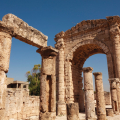AL MEDINA ARCHAEOLOGICAL SITE
The Al Medina site is just a few minutes'walk from the port of Tyre. These are the ruins of the imperial Roman city which extends to the southern end of the peninsula. The site is also known as El Mina. The visit is splendid at the end of the afternoon at sunset. The lights on the main road to the colonnade are very beautiful with the sea view.
A 11 m wide Roman path, lined with columns of cipolin marble, led to the Egyptian port. This gangway was originally covered in a mosaic area forming large white circles. Because of the fragility of the materials used, we decided in the th century. to cover these mosaics of a marble slab.
On the other side of the Roman trail, the arena was extended to approximately 2 000 spectators. It was raised in the first century. Rectangulaire (which is very rare), this arena is surrounded by five rows of stands. All around, large tanks made of lime, used to serve as freshwater reservoirs.
Left of the Roman lane extended the thermal baths built on the embankment of the old port. To avoid infiltration of moisture, the thermal baths were installed on a set of limestone vaults surmounted by brick walls covered with marble and stone. Small pillars or hypocaustes, formed of pieces of terracotta, polishes the soil. The warm air, fed by a stove, was used for the different parts.
At the end of the large aisle was the Greek era (th century. The palaestra (gymnasium), which, following a fire, collapsed in the «Egyptian» port. The inhabitants built this place in public landfill and then, having gained land on the sea, the Romans took ownership to build the palaestra. One can still see the nine grey granite columns in Aswan (Upper Egypt) that were part of this building. In Byzantine times, a purple factory was created on this site.
Located near this site (see map), it is possible to visit the remains of the cathedral. Originally, the site appears to have been occupied by the famous temple of Melkart-Hercules. According to the stories, this temple surpassed all the monuments of the region. Two columns of gold and emerald were planted at the entrance to the building. Unfortunately, there's nothing left of this temple, if these are the huge columns of Aswan Pink Granite, recovered by the crusaders to raise their cathedral. It, built above a Roman track, is no longer just a vast field of ruins. Yet it was - in the th century - the place of grandiose ceremonies. Indeed, in 1187, following the resumption of Jerusalem by Saladin, the crusaders travelled to Tyre and celebrated in the cathedral of weddings and royal coronations. Similarly, in 1192 the remains of Fréderic I Barbarossa, the emperor of the West, was temporarily deposited in the cross cathedral. A grid gives access to the ruins, it is generally open. If not, the site can only be observed from the street.
Did you know? This review was written by our professional authors.
Members' reviews on AL MEDINA ARCHAEOLOGICAL SITE
The ratings and reviews below reflect the subjective opinions of members and not the opinion of The Little Witty.


